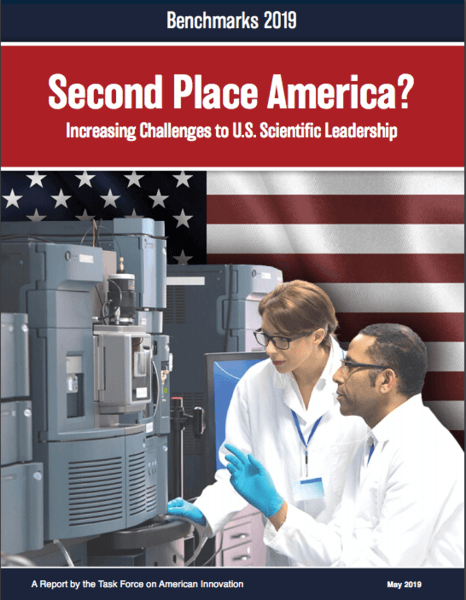Second-Place America? New Report Highlights Mounting Global Competition for Technology Leadership
Tuesday, May 14, 2019, 11:55am
by David Isaacs, Vice President, Government Affairs
America’s competitive edge is at risk, as China and other competing countries take bold steps aimed at surpassing the U.S. as the global technology leader, according to a report released today by the Task Force on American Innovation (TFAI), an alliance of U.S. leaders in business, science, and academia.
 The report, titled Second Place America: Increasing Challenges to U.S. Scientific Leadership, assesses a series of science and technology benchmarks and finds America’s global standing in these areas is slipping. Much like SIA’s policy blueprint, released last month, the TFAI report calls for more robust U.S. government investment in science, technology, and talent to overcome competition from overseas governments and sustain America’s global technology leadership.
The report, titled Second Place America: Increasing Challenges to U.S. Scientific Leadership, assesses a series of science and technology benchmarks and finds America’s global standing in these areas is slipping. Much like SIA’s policy blueprint, released last month, the TFAI report calls for more robust U.S. government investment in science, technology, and talent to overcome competition from overseas governments and sustain America’s global technology leadership.
Among the report’s key findings:
- Research: Since 1995, the U.S. share of global research and development (R&D) has declined significantly, and America is one of only a few countries whose public-sector R&D investment as a share of GDP has declined by over 15 percent since 1995.
- Innovation: The U.S. global share of research publications fell from 27 percent in 2003 to 18 percent in 2016. China’s share increased from 7 percent to 19 percent over the same period, overtaking the U.S.
- Education: The U.S. trails key competitors in the number of bachelor’s degrees in science and engineering awarded since 2000, and China’s output of such degrees has increased by over 360 percent during that time.
- Workforce: There are more researchers in China than in the United States. In 2015, the estimated number of total researchers in China was more than 1.6 million, compared to 1.3 million in the United States.
- Technology: In 2005, the U.S. controlled almost half of the world’s 500 fastest supercomputers. It now controls less than a quarter.
To help reverse these troubling trends and sustain U.S. leadership in semiconductors and the technologies of the future like artificial intelligence, quantum computing, and advanced wireless networks, bold federal policies are needed. SIA’s policy blueprint calls on U.S. policymakers to take the following actions:
1) Triple federal investments in semiconductor-specific research to $5 billion annually and double federal funding for semiconductor-related research in fields such as materials science, computer science, engineering, and applied mathematics to $40 billion annually.
2) Increase the number of green cards for qualified science, technology, engineering, and mathematics (STEM) graduates and increase federal funding for STEM education by 50 percent to over $1.5 billion per year to double the number of American STEM graduates by 2029.
3) Approve free trade agreements, including the United States-Mexico-Canada Agreement, that remove market barriers, protect IP, and enable fair competition. Increase resources for law enforcement and intelligence agencies to prevent and prosecute semiconductor IP theft.
The United States has a head start in the race for global leadership in the must-win technologies of the future, but other countries are gaining ground. To keep America on top, Congress and the Administration should make it a priority to advance policies that strengthen U.S. leadership in science, technology, and talent.
